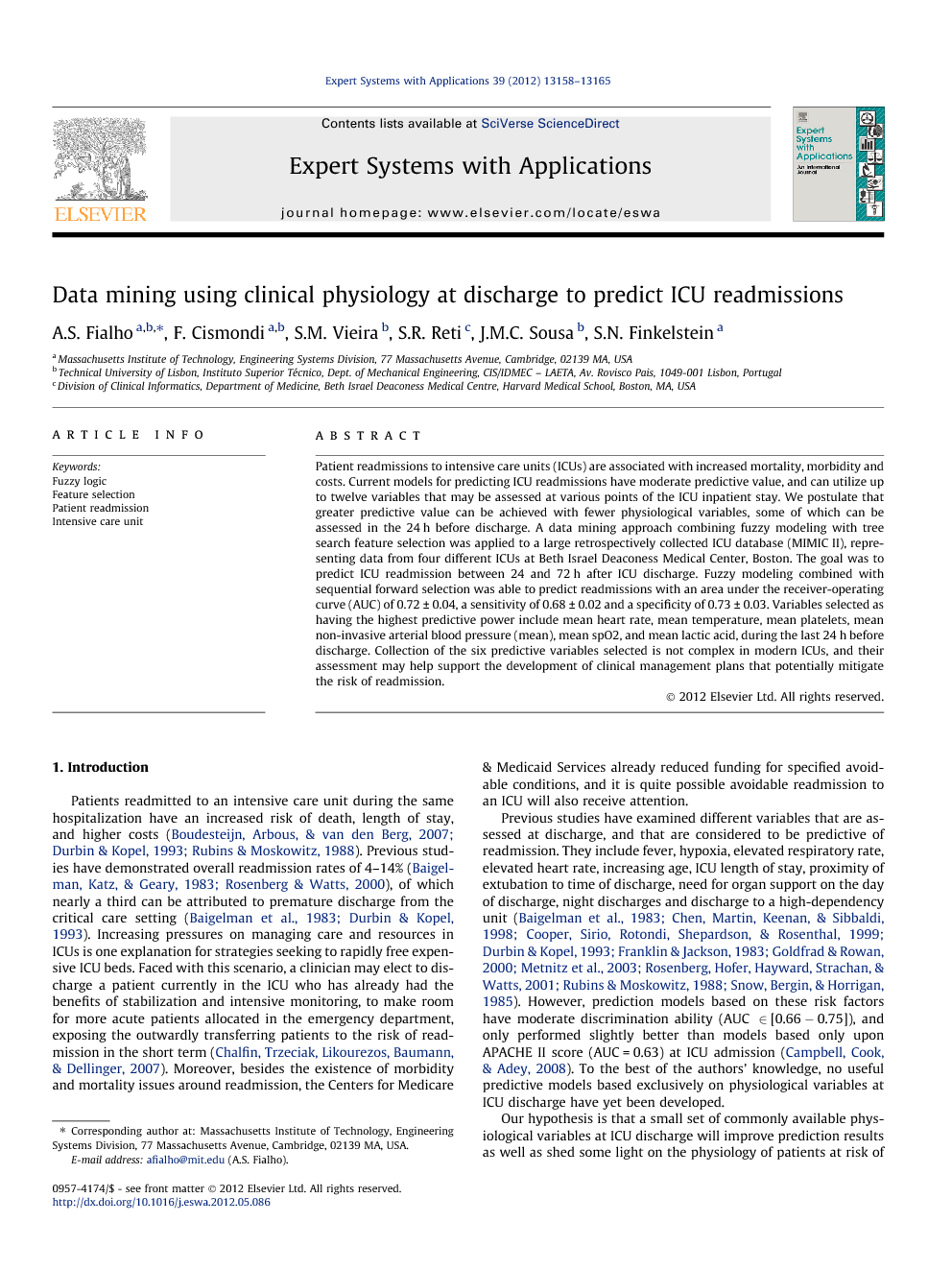Patient readmissions to intensive care units (ICUs) are associated with increased mortality, morbidity and costs. Current models for predicting ICU readmissions have moderate predictive value, and can utilize up to twelve variables that may be assessed at various points of the ICU inpatient stay. We postulate that greater predictive value can be achieved with fewer physiological variables, some of which can be assessed in the 24 h before discharge. A data mining approach combining fuzzy modeling with tree search feature selection was applied to a large retrospectively collected ICU database (MIMIC II), representing data from four different ICUs at Beth Israel Deaconess Medical Center, Boston. The goal was to predict ICU readmission between 24 and 72 h after ICU discharge. Fuzzy modeling combined with sequential forward selection was able to predict readmissions with an area under the receiver-operating curve (AUC) of 0.72 ± 0.04, a sensitivity of 0.68 ± 0.02 and a specificity of 0.73 ± 0.03. Variables selected as having the highest predictive power include mean heart rate, mean temperature, mean platelets, mean non-invasive arterial blood pressure (mean), mean spO2, and mean lactic acid, during the last 24 h before discharge. Collection of the six predictive variables selected is not complex in modern ICUs, and their assessment may help support the development of clinical management plans that potentially mitigate the risk of readmission.
Patients readmitted to an intensive care unit during the same hospitalization have an increased risk of death, length of stay, and higher costs (Boudesteijn et al., 2007, Durbin and Kopel, 1993 and Rubins and Moskowitz, 1988). Previous studies have demonstrated overall readmission rates of 4–14% (Baigelman et al., 1983 and Rosenberg and Watts, 2000), of which nearly a third can be attributed to premature discharge from the critical care setting (Baigelman et al., 1983 and Durbin and Kopel, 1993). Increasing pressures on managing care and resources in ICUs is one explanation for strategies seeking to rapidly free expensive ICU beds. Faced with this scenario, a clinician may elect to discharge a patient currently in the ICU who has already had the benefits of stabilization and intensive monitoring, to make room for more acute patients allocated in the emergency department, exposing the outwardly transferring patients to the risk of readmission in the short term (Chalfin, Trzeciak, Likourezos, Baumann, & Dellinger, 2007). Moreover, besides the existence of morbidity and mortality issues around readmission, the Centers for Medicare & Medicaid Services already reduced funding for specified avoidable conditions, and it is quite possible avoidable readmission to an ICU will also receive attention.
Previous studies have examined different variables that are assessed at discharge, and that are considered to be predictive of readmission. They include fever, hypoxia, elevated respiratory rate, elevated heart rate, increasing age, ICU length of stay, proximity of extubation to time of discharge, need for organ support on the day of discharge, night discharges and discharge to a high-dependency unit (Baigelman et al., 1983, Chen et al., 1998, Cooper et al., 1999, Durbin and Kopel, 1993, Franklin and Jackson, 1983, Goldfrad and Rowan, 2000, Metnitz et al., 2003, Rosenberg et al., 2001, Rubins and Moskowitz, 1988 and Snow et al., 1985). However, prediction models based on these risk factors have moderate discrimination ability (AUC ∈ [0.66 − 0.75]), and only performed slightly better than models based only upon APACHE II score (AUC = 0.63) at ICU admission (Campbell, Cook, & Adey, 2008). To the best of the authors’ knowledge, no useful predictive models based exclusively on physiological variables at ICU discharge have yet been developed.
Our hypothesis is that a small set of commonly available physiological variables at ICU discharge will improve prediction results as well as shed some light on the physiology of patients at risk of readmission. The main goal of this work is to identify which of these physiological variables assessable at discharge from an ICU are most predictive of readmission within 24–72 h. We used a data mining approach combining fuzzy modeling with tree search feature selection to a large ICU database (Mendonça, Vieira, & Sousa, 2007). Results are compared to two of the best-known and most widely used medical scores-APACHE II and APACHE III (Knaus et al., 1985 and Knaus et al., 1991).
The outline of the work is as follows. In Section 2, we describe the basics of fuzzy modeling and overview the principles of the tree-based feature selection. The setup of the models is presented in Section 3 followed by a description of the used database in Section 4. In Section 5 we present the results from the empirical study described. The discussion is presented in Section 6 and conclusions are drawn in Section 7.
Recognizing and managing patients at high risk of ICU readmission is important for maximizing patient outcomes and minimizing admission costs. In this study, a prediction algorithm based on fuzzy modeling combined with sequential forward selection is proposed and compared to other techniques (fuzzy modeling combined with sequential backward elimination, fuzzy modeling using APACHE II variables, and fuzzy modeling using APACHE III variables). Using this methodology we show that it is possible to use a small number of physiological variables immediately prior to discharge to correctly predict readmitted patients. Together with heart rate, the most predictive risk factor and quite possibly the simplest to acquire, temperature, platelets, non-invasive arterial blood pressure (mean), spO2 and lactic acid were also found to be significant in the prediction of ICU readmissions. The proposed model achieved a significantly higher performance, with an average AUC of 0.72.
Future work will entail validating the present results against different ICU databases, and a further simplification of the models by using only monitoring signals sampled at high frequency and shortly before discharge, such as: heart rate, respiratory rate, spO2, non-invasive arterial blood pressure (systolic) and non-invasive arterial blood pressure (mean).


